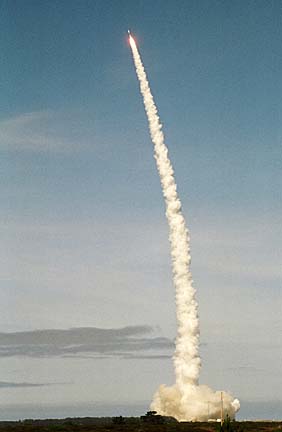
JJIM BORG / JBORG@STARBULLETIN.COM
NASA's Gravity Probe B lifted off Tuesday from Vandenberg Air Force Base.
NASA probe is testing
the properties of gravity
VANDENBERG AIR FORCE BASE, Calif. >> On a booster flame more brilliant than the sun, a Delta II rocket rises into the clear morning sky above the central California coast. Quickly accelerating against the Earth's inexorable pull, it arcs to the south toward a 400-mile-high polar orbit, leaving a pillar of smoke in its path.
Within minutes, the rocket carrying a $700-million NASA gravity experiment has cleared its first hurdle: conquering gravity.
More than 300 years after the fabled apple hit Newton's head, gravity remains a phenomenon more commonly felt than fathomed. Everyone from babies to bungyjumpers understands its effects, but few people outside a small scientific circle really claim to know how it works.
With the launch Tuesday of NASA's Gravity Probe B, two of the last esoteric properties of gravity predicted by Einstein will be put to empirical test.
Physicists are betting Einstein is right. But if he's proved wrong, it will mean going back to the drawing board on nearly nine decades of accepted theory.
Among the scientists watching the launch was University of Hawaii physicist Eric Szarmes, who has been following the project since he was a graduate student at Stanford University.
"I thought it was really spectacular," said Szarmes, who was at Vandenberg with his wife, Charlotte, and sons Colin, 12, and Duncan, 10. "I've never seen a rocket launch before. To see the engine light and the thing shoot off was just amazing."
His interest runs deeper than that of a gee-whiz tourist, but Szarmes is quick to admit that most metaphors are woefully inadequate to explain the workings of gravity.
That's because everyday experiences don't easily translate into a realm where seemingly empty space is called four-dimensional "spacetime" and is bent by the presence of matter.
Once believed to be a force of attraction like magnetism, gravity now is described as a field in which objects follow the shortest, easiest path.
Curved spacetime often has been compared to the depression a bowling ball makes in a mattress. A nearby marble would roll into the depression much like a meteor plummets to Earth.
The weakness of the bowling-ball metaphor is that the marble, in rolling into the depression, is obeying gravity from somewhere under the mattress; it's a model that uses gravity to define gravity.
"That analogy has always been difficult," Szarmes said. "The bowling ball on the mattress is also restricted in the number of dimensions it employs. There is no concept of time in that model."
A better analogy, Szarmes said, is to imagine two marbles rolling north from different spots on the equator of a sphere. The surface of the sphere represents the curvature of spacetime.
The marbles start out in parallel directions, but eventually come together at the North Pole.
But what if the marbles are stationary at the equator?
Then the north-south dimension is time, Szarmes says.
The marbles, though initially motionless, must follow a path through time, he says, and gravity makes those paths converge.
With Gravity Probe B, scientists at NASA and Stanford hope to prove that the Earth's gravity warps nearby spacetime in ways measurable by rapidly spinning, golfball-sized quartz gyroscopes. They aim to demonstrate that the planet's mass not only bends the cosmic fabric -- the so-called geodetic effect -- but also "drags" a bit of it in the direction of its orbit.
The second effect, called "frame dragging," is comparable to liquid in a cup that swirls so fast it moves the cup.
Gravity Probe B, conceived in 1959, has suffered repeated delays and was almost canceled seven times. Detractors argue that Einstein's theories are already well established and that the experiment will add nothing new. Its supporters note the project has produced a wealth of technological breakthroughs.
Said Szarmes: "Many people who have heard of the theory of relativity or read popular accounts of it may have the impression that its effects are utterly minuscule and could not have any practical applications.
"I think they would be surprised to know that the hand-held GPS receivers that they can buy for less than $100 simply would not work if the Einsteinian curvature of spacetime around the earth was not included in the design.
"Rather, neglecting this curvature would lead to cumulative errors of roughly 11 kilometers per day."
